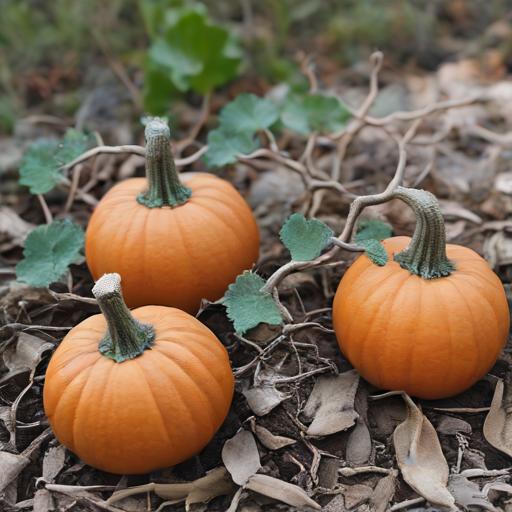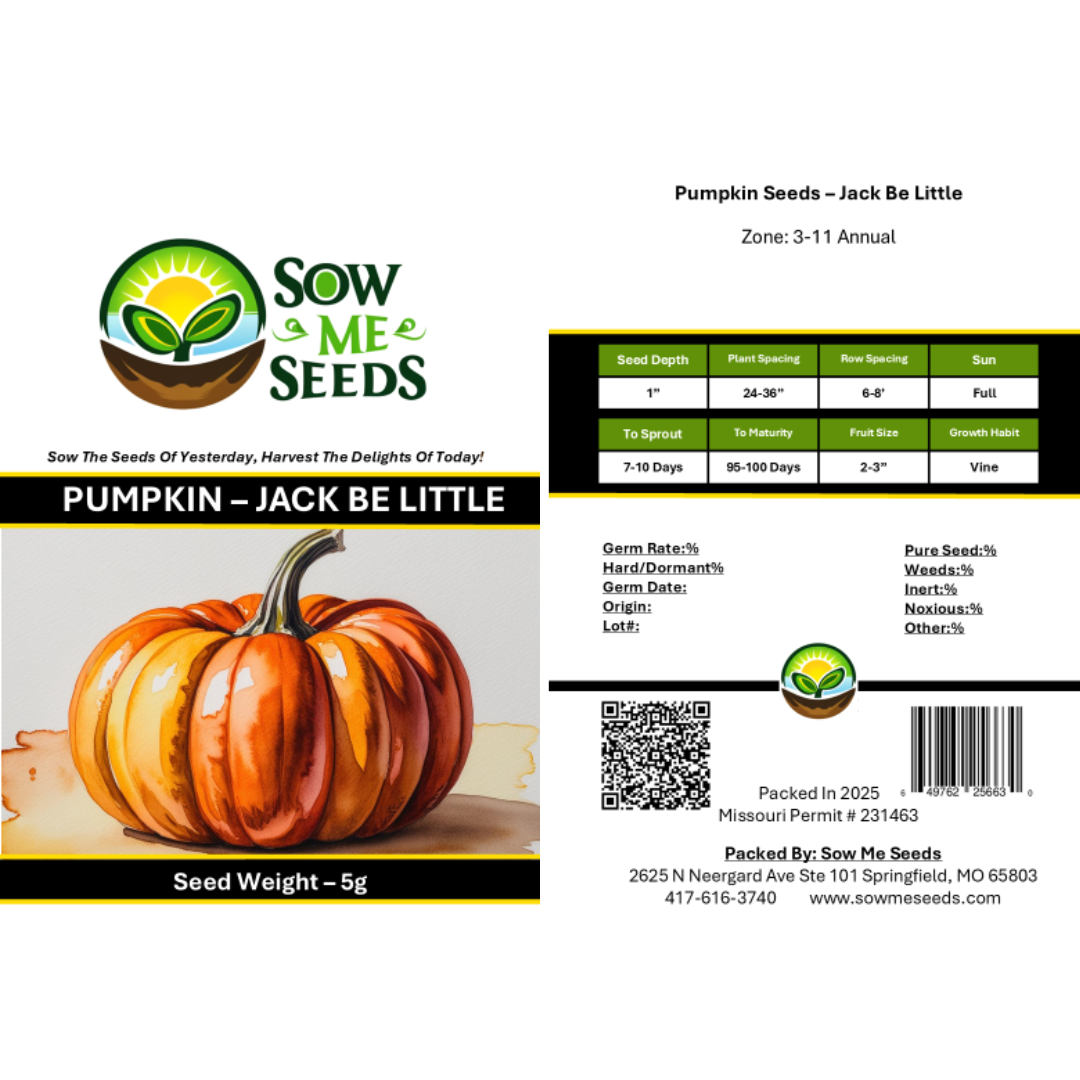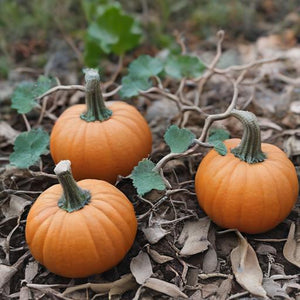- Hardiness Zone: 2-11 Annual
Seed Depth: 1 inch
Seed Spacing: 18–24 inches
Row Spacing: 6–8 feet
Sunlight: Full sun
Days to Sprout: 7–10 days
Days to Maturity: 95–100 days
Growth Habit: Compact, trailing vine
Sunlight: Thrives in full sun, requiring at least 6–8 hours of direct sunlight daily.
Soil Type: Prefers well-drained, fertile soil with a pH of 6.0–7.5. Add compost or organic matter to enrich the soil.
When to Plant: Sow seeds directly outdoors after the last frost, when soil temperatures reach 70°F or higher.
Direct Sowing: Plant seeds 1 inch deep, spacing them 18–24 inches apart in rows 6–8 feet apart or in hills with 2–3 seeds per hill. Thin to the strongest seedling.
Indoor Sowing: Start seeds indoors 2–3 weeks before the last frost and transplant carefully to avoid disturbing roots.
Succession Planting: Not typically needed; pumpkins produce a single harvest.
Watering: Water deeply and consistently, keeping the soil evenly moist but not soggy. Avoid overhead watering to reduce disease risk.
Fertilizing: Apply a balanced fertilizer at planting and a phosphorus-rich fertilizer when flowers appear.
Pruning: Trim excessive vines to focus energy on fruit development.
Pest and Disease Control: Monitor for squash bugs, vine borers, and powdery mildew. Use row covers or organic treatments as needed.
When to Harvest: Harvest when the skin is firm and a bright orange color, typically 95–100 days after planting. The stem should be dry and woody.
How to Harvest: Cut pumpkins from the vine with a sharp knife, leaving 2–4 inches of stem attached to prolong storage life. Handle carefully to avoid bruising.
Seed Collection: Scoop seeds from fully ripened fruit, rinse, and dry thoroughly.
Storing Seeds: Store seeds in an airtight container in a cool, dry place.
Why You’ll Love It
Mini & Mighty: Petite pumpkins that are just 3–4 inches wide — adorable and functional.
Dual Purpose: Great for decoration and fully edible with a subtly sweet flavor.
Fast Growing: Matures quickly for early fall harvests or season-long production.
Kid-Friendly Size: A fun choice for children’s gardens or crafting projects.
Plant Characteristics
Height: Vines grow 12–18 inches tall
Growth Habit: Sprawling vines with vigorous growth and prolific fruiting
Fruit Type: Small, ribbed, bright-orange pumpkins (3–4 inches wide, ½–1 lb each)
Days to Maturity: 90–100 days
Hardiness: Warm-season annual
Flavor and Culinary Uses
Flavor: Mild and slightly sweet with a smooth texture when baked
Culinary Uses: Perfect for baking whole, stuffing, roasting, or puréeing for mini pies
Companion Planting Tips
Good Companions: Corn, beans, marigolds, and sunflowers
Avoid Planting Near: Potatoes and brassicas that may compete for nutrients
Bonus Benefit: Excellent pollinator attraction and decorative appeal for fall displays
Common Issues and Solutions
Powdery Mildew: Encourage airflow and water at the base; treat early if needed
Poor Pollination: Hand-pollinate flowers early in the day for best results
Fruit Rot: Keep fruits off the ground with mulch or boards to prevent moisture damage
Seeds Per Packet
| 5g | Approximately 80 |
| 15g | Approximately 240 |
Why You’ll Love It
Mini & Mighty: Petite pumpkins that are just 3–4 inches wide — adorable and functional.
Dual Purpose: Great for decoration and fully edible with a subtly sweet flavor.
Fast Growing: Matures quickly for early fall harvests or season-long production.
Kid-Friendly Size: A fun choice for children’s gardens or crafting projects.
Plant Characteristics
Height: Vines grow 12–18 inches tall
Growth Habit: Sprawling vines with vigorous growth and prolific fruiting
Fruit Type: Small, ribbed, bright-orange pumpkins (3–4 inches wide, ½–1 lb each)
Days to Maturity: 90–100 days
Hardiness: Warm-season annual
Flavor and Culinary Uses
Flavor: Mild and slightly sweet with a smooth texture when baked
Culinary Uses: Perfect for baking whole, stuffing, roasting, or puréeing for mini pies
Companion Planting Tips
Good Companions: Corn, beans, marigolds, and sunflowers
Avoid Planting Near: Potatoes and brassicas that may compete for nutrients
Bonus Benefit: Excellent pollinator attraction and decorative appeal for fall displays
Common Issues and Solutions
Powdery Mildew: Encourage airflow and water at the base; treat early if needed
Poor Pollination: Hand-pollinate flowers early in the day for best results
Fruit Rot: Keep fruits off the ground with mulch or boards to prevent moisture damage
Seeds Per Packet
| 5g | Approximately 80 |
| 15g | Approximately 240 |




Share and get 15% off!
Simply share this product on one of the following social networks and you will unlock 15% off!